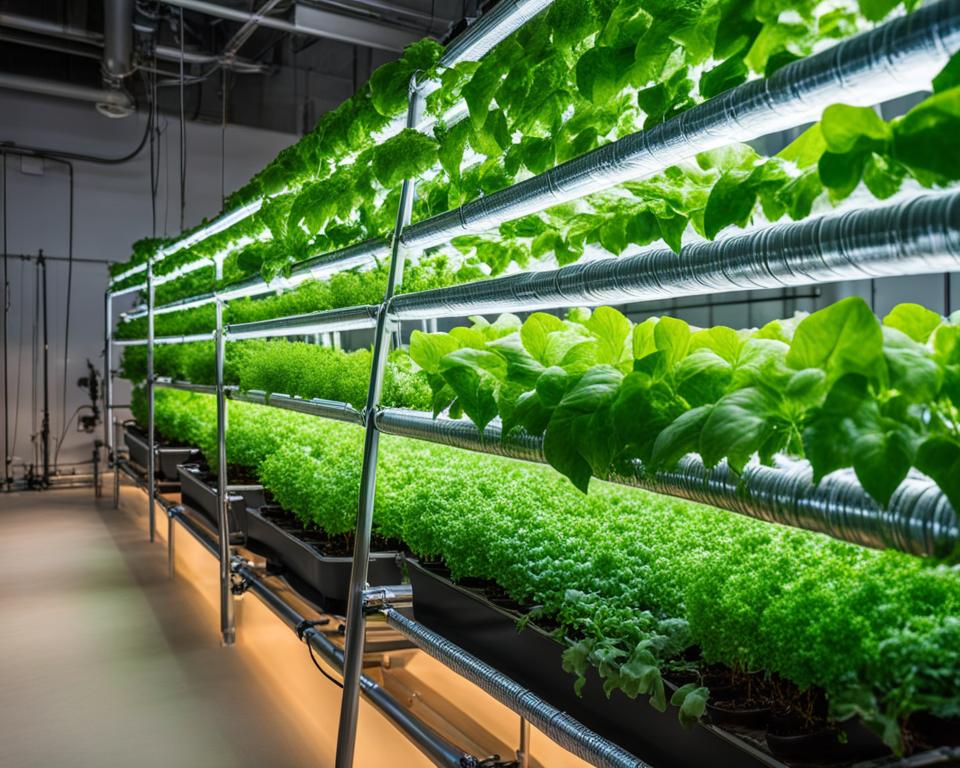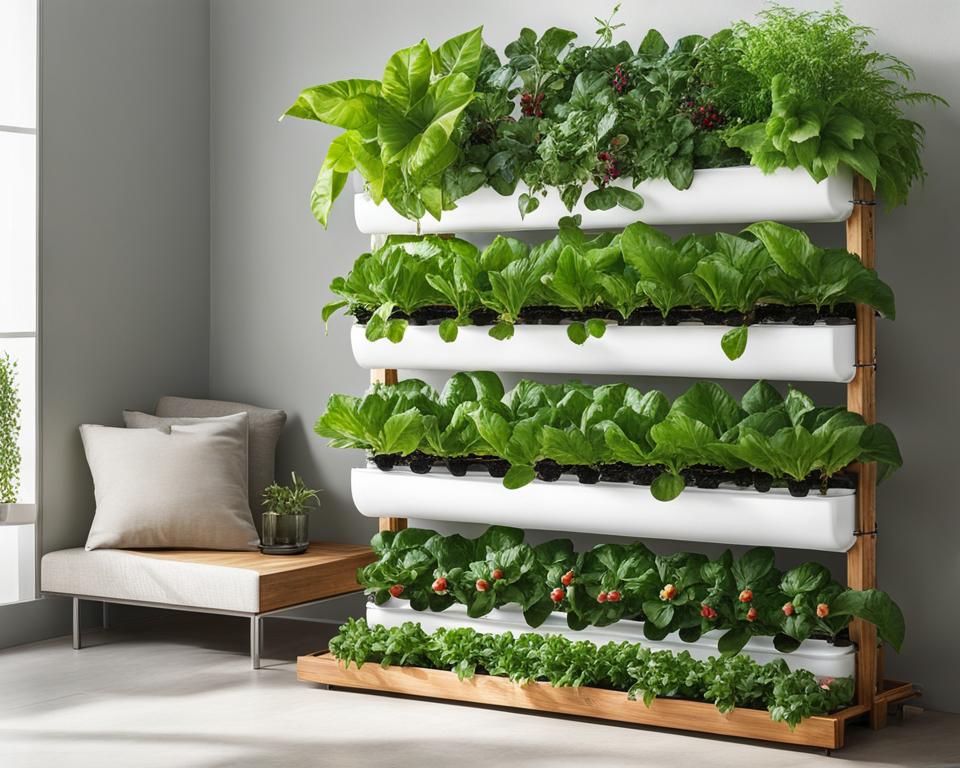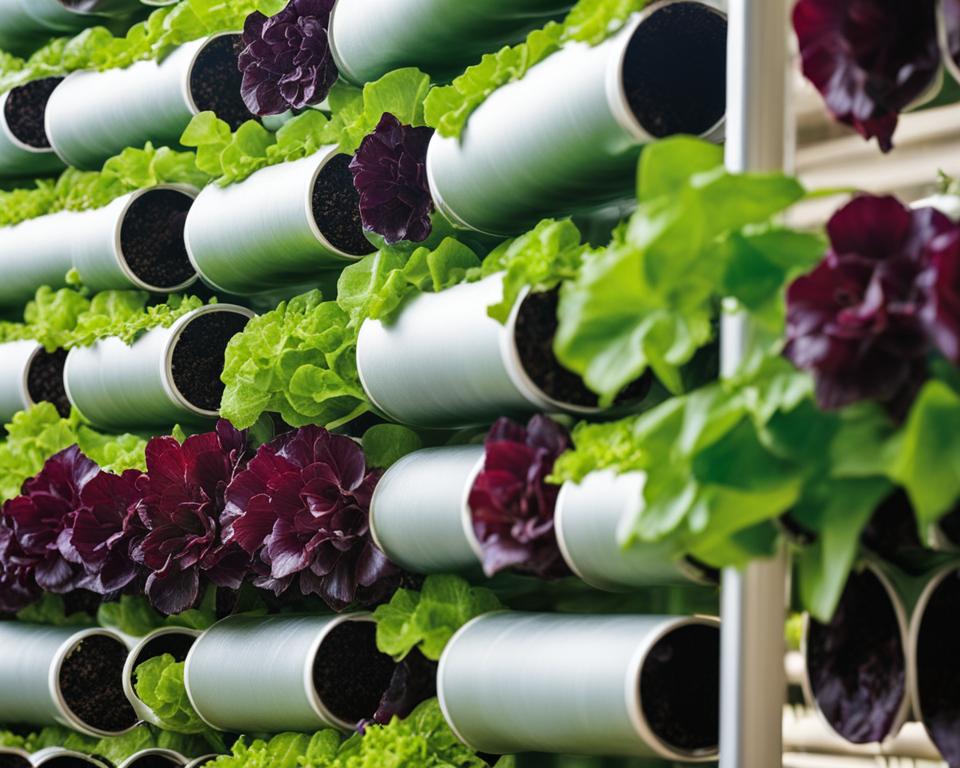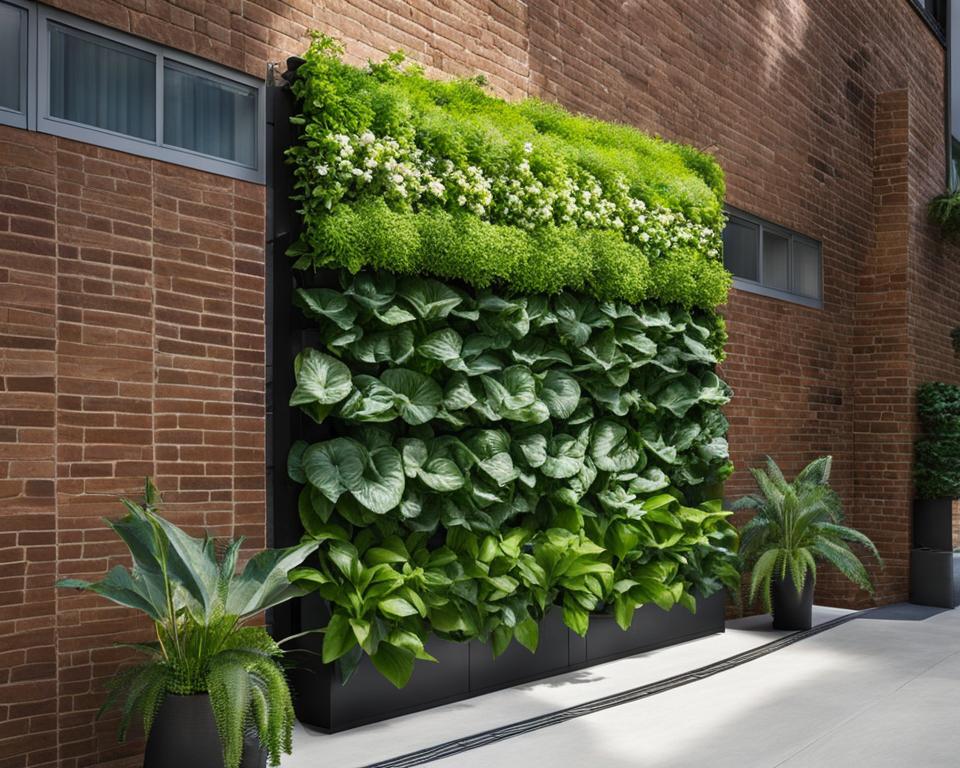Are you looking for a revolutionary way to transform your green space? Consider hydroponic vertical gardening systems. These innovative systems allow you to cultivate plants without soil, using a nutrient-rich water solution and a vertical structure. Not only do they save space, but they also offer an eco-friendly approach to gardening.
Hydroponic vertical gardens are gaining popularity among urban dwellers who have limited space but still want to enjoy the benefits of gardening. Whether you have a small apartment or a rooftop terrace, these systems can help you create a lush and sustainable indoor garden.
Key Takeaways:
- Hydroponic vertical gardening systems allow you to grow plants without soil, using a nutrient-rich water solution and a vertical structure.
- These systems are perfect for urban environments where space is limited.
- Hydroponic vertical gardens offer benefits such as water efficiency, faster growth, higher yields, and fewer pests and diseases.
- You can set up and maintain a hydroponic vertical garden by assembling the structure, preparing the plants, mixing the nutrient solution, establishing the water circulation system, and monitoring the pH and nutrient levels.
- Get creative with your hydroponic vertical garden by creating living walls, edible art, or themed gardens.
Understanding Hydroponic Vertical Gardens
Hydroponic vertical gardens, like the Gardyn hydroponic garden, combine the techniques of hydroponics and vertical gardening to create a unique and efficient way to cultivate plants in urban environments. Hydroponics involves growing plants in a nutrient-rich water solution, eliminating the need for soil. Vertical gardening, on the other hand, refers to growing plants on a vertical structure to maximize space utilization. By merging these concepts, hydroponic vertical gardens offer a sustainable and space-saving solution for urban dwellers.
Urban environments often have limited space for traditional gardening methods. With hydroponic vertical gardens, residents can make the most of their living spaces by growing plants on vertical structures. These systems provide an excellent opportunity for urban farming and sustainable gardening in areas where land is scarce. Not only do hydroponic vertical gardens optimize space, but they also offer an eco-friendly approach to gardening by conserving water and reducing the risk of soil-borne pests and diseases.
If you’re looking to create a hydroponic vertical garden, consider investing in a high-quality system like the Gardyn. This all-in-one system comes with everything you need to get started, including a vertical structure, growing medium, nutrient solution, and water circulation system. With careful assembly and maintenance, you can enjoy the benefits of a thriving hydroponic vertical garden right in your own home or apartment.
Benefits of Hydroponic Vertical Gardens
Hydroponic vertical gardens bring a multitude of benefits to gardeners, making them an attractive option for those looking to revamp their green spaces. One of the key advantages of these gardens is their space-saving design. With vertical structures that utilize height instead of spreading out horizontally, hydroponic vertical gardens are perfect for urban dwellers with limited space.
Another significant benefit is their water efficiency. These gardens use up to 90% less water compared to traditional soil-based gardening. By delivering a nutrient-rich water solution directly to the plants’ roots, hydroponic systems reduce water waste and contribute to water conservation efforts.
In addition to space-saving and water-efficient design, hydroponic vertical gardens offer faster growth and higher yields. With precise control over nutrient levels and optimal growing conditions, plants grown hydroponically tend to experience accelerated growth. This means you can enjoy a bountiful harvest in a shorter period. Furthermore, the absence of soil in hydroponic vertical gardens reduces the risk of pests and diseases, resulting in healthier and more robust plants.
Table: Comparing the Benefits of Hydroponic Vertical Gardens
| Benefits | Hydroponic Vertical Gardens | Traditional Soil-based Gardening |
|---|---|---|
| Space-saving | ✓ | ✗ |
| Water efficiency | ✓ | ✗ |
| Faster growth | ✓ | ✗ |
| Higher yields | ✓ | ✗ |
| Fewer pests and diseases | ✓ | ✗ |
Components of a Hydroponic Vertical Garden

A hydroponic vertical garden consists of several key components that work together to provide optimal growing conditions for plants. Understanding these components is essential for successful hydroponic gardening. Let’s explore each component in detail:
1. Vertical Structure
The vertical structure serves as the foundation of a hydroponic vertical garden. It can be wall-mounted panels or freestanding towers. The purpose of the vertical structure is to support the growing medium and provide a space-saving solution for urban environments.
2. Growing Medium
The growing medium in a hydroponic vertical garden replaces traditional soil and provides stability and support for the plants’ root systems. Commonly used growing mediums include coco coir, rockwool, perlite, and clay pellets. The growing medium acts as a reservoir for the nutrient solution, allowing the plants to access the necessary nutrients and water.
3. Nutrient Solution
The nutrient solution is a vital component of hydroponic vertical gardens as it provides the essential nutrients for plant growth. This solution is a carefully balanced mixture of water and nutrients such as nitrogen, phosphorus, and potassium. The nutrient solution is circulated through the growing medium, delivering the necessary nutrients directly to the plant roots.
4. Water Circulation System
The water circulation system ensures the continuous flow of the nutrient solution throughout the hydroponic vertical garden. It typically consists of a pump and tubing that transports the nutrient-rich water from a reservoir to the plants. The water circulation system plays a crucial role in maintaining the proper balance of nutrients and oxygen levels for healthy plant growth.
With these key components in place, a hydroponic vertical garden provides an efficient and space-saving solution for growing plants. By understanding how each component functions and interacts with the others, you can create a thriving garden that maximizes space utilization and yields healthy, nutrient-rich produce.
Types of Hydroponic Vertical Garden Systems

When it comes to hydroponic vertical gardening, there are several types of systems to choose from. Each system offers its own unique benefits and advantages, allowing you to find the one that best suits your needs and preferences. Let’s explore some of the most popular types:
Nutrient Film Technique (NFT)
The Nutrient Film Technique (NFT) is a widely used hydroponic system that involves a thin film of nutrient-rich water flowing over the plant roots. This technique allows plants to have continuous access to water and nutrients, promoting efficient nutrient absorption and faster growth. NFT systems are ideal for growing leafy greens and herbs.
Aeroponics
Aeroponics is a cutting-edge hydroponic system that delivers nutrients and moisture to the plant roots through a mist or fine spray. The plants are suspended in the air, with their roots exposed, which allows for maximum oxygenation and nutrient absorption. Aeroponic systems are known for their high water efficiency and suitability for growing a wide range of plants, including vegetables and fruits.
Drip Irrigation
Drip irrigation is a popular and versatile hydroponic system that involves the delivery of a nutrient solution directly to the plant roots through tubes and drip emitters. This system is highly customizable, allowing you to control the amount and frequency of nutrient solution delivered to each plant. Drip irrigation is suitable for a variety of crops and can be easily adapted to vertical gardening setups.
Wick Systems
Wick systems are one of the simplest and most low-maintenance hydroponic systems available. They use absorbent wicks to transport the nutrient solution from a reservoir to the plant roots. Wick systems are passive and do not require any pumps or electricity, making them an excellent choice for beginners or those looking for a hassle-free gardening experience. However, they are best suited for smaller plants with low nutrient requirements.
Each type of hydroponic vertical garden system has its own unique characteristics and advantages. Consider your specific needs, resources, and desired plant selection to choose the system that will help you achieve optimal results.
Setting Up and Maintaining a Hydroponic Vertical Garden

When it comes to setting up and maintaining a hydroponic vertical garden, there are several essential steps to follow. By carefully assembling the structure, preparing the plants, mixing the nutrient solution, establishing the water circulation system, and monitoring and adjusting key factors, you can ensure the success of your garden and enjoy a thriving harvest.
Structure Assembly
Begin by assembling the vertical structure of your hydroponic vertical garden according to the provided instructions. Whether you opt for wall-mounted panels or freestanding towers, make sure each component is securely in place. This will provide the stability and support necessary for your plants to grow and thrive.
Plant Preparation
Next, carefully transplant your seedlings into the chosen growing medium. Coco coir and rockwool are popular options that retain moisture and provide excellent drainage. Ensure that each plant’s roots are well-covered and supported in the growing medium to encourage healthy growth.
Nutrient Solution Mixing
Mixing the right nutrient solution is crucial for the success of your hydroponic vertical garden. Follow the provided guidelines to create a balanced solution that contains all the necessary nutrients for optimal plant growth. Pay attention to the recommended ratios and adjust the solution as needed to meet the specific requirements of your plants.
Water Circulation System Establishment
Establishing a reliable water circulation system is key to delivering the nutrient-rich water to your plants consistently. Set up a pump and tubing that will distribute the water solution evenly throughout the vertical garden. Ensure that the water circulation system is functioning correctly and delivering the proper amount of water to each plant.
Monitoring and Adjustment
Regular monitoring and adjustment of key factors such as pH and nutrient levels are essential for maintaining a healthy hydroponic vertical garden. Use a pH meter to test the acidity of the nutrient solution and make any necessary adjustments to keep it within the optimal range for your plants. Similarly, monitor nutrient levels and adjust as needed to provide an optimal growing environment.
By following these steps and dedicating time to regular maintenance, you can set up and maintain a flourishing hydroponic vertical garden. Remember to prune and harvest your plants as needed to ensure optimal growth and enjoy the benefits of fresh, homegrown produce.
Tips for Successful Hydroponic Vertical Gardening

When it comes to successful hydroponic vertical gardening, there are several key factors to keep in mind. From selecting the right plants to maintaining optimal conditions, these tips will help you create thriving gardens in your urban space.
Plant Selection
Choosing the right plants for your hydroponic vertical garden is crucial. Look for plants with shallow root systems that thrive in nutrient-rich water solutions. Some popular options include lettuce, herbs like basil and cilantro, and leafy greens like spinach and kale. Consider the space available and the desired aesthetic to select plants that will flourish in your vertical garden.
Lighting
Proper lighting is essential for the healthy growth of your hydroponic plants. If your garden receives natural sunlight, ensure that the plants are positioned to receive adequate light throughout the day. If natural light is limited, supplement with artificial grow lights. LED grow lights are an energy-efficient option that provides the optimal light spectrum for plant growth.
pH and Nutrient Monitoring
Regularly monitor and adjust the pH and nutrient levels in your hydroponic system. Most plants thrive in a slightly acidic pH range, around 5.5-6.5. Use a pH meter or test strips to ensure that the water solution remains within the desired range. Additionally, check the nutrient levels to provide the right balance of essential elements for plant growth.
Air Circulation
Proper air circulation is vital for preventing issues like mold and diseases in your hydroponic vertical garden. Use fans or vents to maintain a gentle breeze that helps prevent stagnant air and encourages transpiration. Good airflow also strengthens plant stems and improves overall plant health.
System Maintenance
Regular maintenance of your hydroponic vertical garden is key to ensuring its long-term success. Keep the system clean by regularly removing any algae or debris that can clog the water circulation system. Inspect the plants for any signs of diseases or pests and take appropriate measures to address them promptly. Regularly check and clean the filters, valves, and pumps to maintain optimal system performance.
| Tips for Successful Hydroponic Vertical Gardening |
|---|
| Plant Selection |
| Choose plants with shallow root systems that thrive in nutrient-rich water solutions. |
| Lighting |
| Ensure plants receive adequate natural sunlight or supplement with artificial grow lights. |
| pH and Nutrient Monitoring |
| Regularly monitor and adjust pH and nutrient levels to provide optimal growing conditions. |
| Air Circulation |
| Maintain proper air circulation to prevent mold and diseases. |
| System Maintenance |
| Regularly clean the system, inspect for pests or diseases, and maintain optimal performance. |
Creative Ideas for Hydroponic Vertical Gardens
Hydroponic vertical gardens provide a world of possibilities for creative and visually stunning green spaces. Let your imagination soar with these innovative ideas:
1. Living Walls
Create a lush and vibrant living wall by covering an entire vertical structure with a variety of plants. Choose a mix of foliage, flowers, and cascading vines to add depth and texture to your garden. Not only does a living wall enhance the aesthetic appeal of your space, but it also improves air quality by naturally filtering pollutants.
2. Room Dividers
Turn your hydroponic vertical garden into a functional and beautiful room divider. Utilize a freestanding system that can be easily moved and positioned to create separate areas in your home or office. Whether you want to divide a large living space or create privacy in a workspace, a hydroponic vertical garden can serve as an eye-catching partition.
3. Edible Art
Combine the beauty of art with the practicality of growing your own food by designing edible art in your hydroponic vertical garden. Arrange plants in patterns or shapes to create living artwork that is both visually appealing and delicious. Experiment with different colors and textures to bring your edible art to life.
4. Hanging Gardens
Add a touch of whimsy to your space by incorporating hanging gardens in your hydroponic vertical garden. Hang small hydroponic containers from the ceiling with sturdy hooks or ropes. This allows you to maximize vertical space and create a stunning display of suspended plants. Choose trailing plants or varieties with cascading foliage for a more dramatic effect.
5. Themed Gardens
Take your hydroponic vertical garden to the next level by designing themed gardens. Whether you’re passionate about culinary herbs, salads, or tropical plants, create a themed garden that reflects your interests and preferences. Arrange plants according to their themes, with carefully selected varieties that thrive in a hydroponic system.
With these creative ideas, you can transform your hydroponic vertical garden into a stunning and functional green space that reflects your personal style and interests. Whether you choose to create living walls, use it as a room divider, dabble in edible art, explore hanging gardens, or design themed gardens, the possibilities are endless. Let your hydroponic vertical garden become a unique and captivating feature in your home or office.
Overcoming Common Challenges in Hydroponic Vertical Gardens
Hydroponic vertical gardens offer a sustainable and efficient way to cultivate plants without soil. However, like any gardening method, they are not without their challenges. Understanding and addressing these challenges is crucial to ensure the success of your hydroponic vertical garden.
One of the key challenges in hydroponic vertical gardens is lighting. Adequate lighting is essential for the proper growth and development of plants. Insufficient lighting can lead to weak growth and poor yields. To overcome this challenge, ensure that your garden receives adequate sunlight or use artificial grow lights. Position the lights properly and monitor the light levels to provide the optimum environment for your plants.
Nutrient imbalances are another common challenge in hydroponic vertical gardens. As you provide plants with a nutrient solution directly, it is important to monitor and adjust the nutrient levels regularly. Imbalances in the nutrient solution can lead to stunted growth and nutrient deficiencies. Regular testing and adjustment of the nutrient solution will help ensure that your plants receive the right balance of essential nutrients.
Root rot is also a challenge that hydroponic vertical gardeners may face. In a soilless environment, proper aeration and drainage are crucial to prevent root rot, which can occur due to overly wet conditions. Ensure that your hydroponic system provides adequate oxygen to the roots and allows excess water to drain properly. Regularly check the roots for any signs of rot and take prompt action to address the issue.
Pest management is an important aspect of maintaining a healthy hydroponic vertical garden. Although hydroponic systems reduce the risk of soil-borne pests, other pests such as aphids or spider mites can still pose a threat. Implement an integrated pest management strategy, which may include physical barriers, beneficial insects, or organic pest control methods. Regular monitoring and early intervention will help prevent pests from causing damage to your plants.
By understanding and proactively addressing these common challenges, you can ensure the success of your hydroponic vertical garden and enjoy the benefits of sustainable and efficient plant cultivation.
Conclusion
In conclusion, hydroponic vertical gardening systems have revolutionized the way we cultivate plants. With their space-saving design and eco-friendly approach, they provide a practical solution for urban dwellers with limited space. By merging hydroponics and vertical gardening techniques, these systems offer a unique and efficient way to grow plants in any urban environment.
Not only do hydroponic vertical gardens maximize space utilization, but they also contribute to water conservation by using up to 90% less water compared to traditional soil-based gardening. The precise nutrient control and optimal growing conditions of hydroponics lead to faster growth and higher yields, while the absence of soil reduces the risk of soil-borne pests and diseases.
Furthermore, hydroponic farming techniques can be scaled up to create vertical greenhouses, allowing for large-scale hydroponic farming. This opens up new possibilities for sustainable food production and enhances the seed life cycle. With proper setup, maintenance, and creative ideas, anyone can achieve thriving hydroponic vertical gardens and enjoy the benefits they offer.
FAQ
What is a hydroponic vertical garden?
A hydroponic vertical garden is a revolutionary way to cultivate plants without soil, using a nutrient-rich water solution and a vertical structure.
How does a hydroponic vertical garden work?
A hydroponic vertical garden consists of a vertical structure, a growing medium, a nutrient solution, and a water circulation system. The plants are grown in the growing medium, and nutrient-rich water is delivered to their roots through the water circulation system.
What are the benefits of hydroponic vertical gardens?
Hydroponic vertical gardens maximize space utilization, use less water, promote faster growth and higher yields, and reduce the risk of soil-borne pests and diseases.
What are the components of a hydroponic vertical garden?
A hydroponic vertical garden consists of a vertical structure, a growing medium, a nutrient solution, and a water circulation system.
What are the types of hydroponic vertical garden systems?
Examples of hydroponic vertical garden systems include the Nutrient Film Technique (NFT), aeroponics, drip irrigation, and wick systems.
How do I set up and maintain a hydroponic vertical garden?
To set up and maintain a hydroponic vertical garden, you need to assemble the vertical structure, transplant seedlings into the growing medium, mix the nutrient solution, establish the water circulation system, and regularly monitor and adjust pH and nutrient levels.
What tips can you provide for successful hydroponic vertical gardening?
Select plants with shallow root systems, provide adequate lighting, monitor and adjust pH and nutrient levels, maintain proper air circulation, and keep the hydroponic system clean to prevent issues like mold or pests.
What are some creative ideas for hydroponic vertical gardens?
You can transform walls into lush living walls, use freestanding systems as room dividers, create edible art with plant patterns or shapes, hang small hydroponic containers from the ceiling, or design themed gardens based on culinary herbs, salads, or tropical plants.
What are the common challenges in hydroponic vertical gardens?
Common challenges in hydroponic vertical gardens include insufficient lighting, nutrient imbalances, root rot, and pests. These challenges can be overcome with proper care and management.
Where can I learn more about hydroponic vertical gardening?
For more information about hydroponic vertical gardening, you can consult gardening resources, visit hydroponic gardening websites, or seek guidance from experts in the field.

